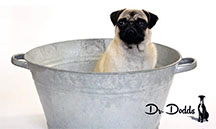Choosing a Companion Dog Shampoo and Bathing
 Hemopet has recently spotlighted the importance of frequent handwashing and choosing hand soap because of SARS-CoV-2, the novel coronavirus that causes COVID-19. At this time, we know of no evidence that pet fur or skin can transmit viruses such as SARS-CoV-2, but fur can transmit certain bacteria and fungi that are unassociated with viruses.
Hemopet has recently spotlighted the importance of frequent handwashing and choosing hand soap because of SARS-CoV-2, the novel coronavirus that causes COVID-19. At this time, we know of no evidence that pet fur or skin can transmit viruses such as SARS-CoV-2, but fur can transmit certain bacteria and fungi that are unassociated with viruses.So, why are we talking about choosing dog shampoos and bathing?
First, let’s talk about bathing frequency. Many of us think that our companion pets do not need to be bathed that much. Actually, dogs with certain skin conditions like atopic dermatitis due to environmental inhalant sensitivities may need to be bathed as often as a few times a week. Bathing will help reduce the bacterial or fungal load that can result from these external sensitivities. For other companion dogs, it is best to bathe them when they are dirty, itchy, stinky, or clearly irritated. Bathing a healthy dog too often can dry out the skin and even alter the normal skin pH.
Are we all having a collective groan? Bathing often entails putting on a bathing suit, coaxing our companion dogs into the bathroom, feeling guilt when we look at their sad faces indicating a betrayal, and cleaning the bathroom afterwards. Additionally, are we all doing it correctly? Dr. Karen Becker gives a detailed tutorial on how to bathe your companion dog that we suggest watching.
Are we now throwing up our hands thinking that it doesn’t matter how many times or how well we wash our dogs that our dogs can still stink in a couple of days? Well, that could be caused by an environmental sensitivity and/or a food sensitivity. Does your dog smell like corn chips? That is more than likely caused by a food sensitivity, yeast overgrowth, or an excessive amount of grain, corn or soy in the diet.
Now, let’s switch back to choosing pet shampoo. Actually, this list below is more about what to avoid.
#1. Do not use human shampoo or soap.
These are pH-balanced for humans – not dogs or cats.
#2. Choose a pet shampoo that lists the ingredients.
Fairly basic.
#3. Do not choose an antibacterial or antifungal shampoo unless…
…recommended or prescribed by your companion dog’s attending veterinarian. As we often discuss here, our primary concern is that we do not want to contribute to, or to potentially cause, harmful bacteria or fungi mutating to the point of resistance to the limited antimicrobial arsenal that is available.
Remember what we said before: we simply want to reduce the bacterial and fungal loads on the skin and fur. Indeed, “good” bacteria and fungi also exist on bodies to fight off the “bad” ones.
#4. Do not choose an antiparasitic shampoo unless…
…recommended or prescribed by your dog’s veterinarian. Again, we do not want to add to antiparasitic resistance.
Bear in mind, we purposefully separated antiparasitic shampoos from the other antimicrobial shampoos because there is an additional component to consider. Pyrethroids are often the “go to” to fight off parasitic infections in dogs. However, they are toxic to cats. So, if cats live in the household, do not choose shampoos with pyrethroids.
Pyrethroids may be listed on the shampoo label as “D-trans Allethrin” or “resmethrin”.
#5. Do not choose oatmeal if…
…your companion dog is sensitive or reactive to oatmeal. Even if you are thinking that the sensitivity to oatmeal is internal, remember that dogs often groom themselves.
In general, grain-based shampoos may actually contribute to bacterial and fungal loads on the skin.
#6. Choose all-natural shampoos.
We know; this is easier said than done.
#7. Do not choose shampoos with rosemary if…
…any of the companion dogs in the household are prone to seizures. While it may likely be fine for most dogs, it is a neurotoxin that can promote seizures in vulnerable dogs. Otherwise, rosemary is a natural ingredient that has anti-inflammatory and preservative qualities. It is often listed as “rosemary officinalis”.
#8. Choose sulfate-free if…
…your dog has dry skin. Sulfates simply make the shampoo sudsy.
Here are some examples:
Sodium lauryl sulfate (not to be confused with sodium laureth sulfate) TEA lauryl sulfate Triethanalomine Alkyl sodium sulfate
#9. Avoid these shampoo preservatives.
Granted, it might be difficult to avoid them, but try your best.
Parabens
Parabens are artificial ingredients added to shampoos and other consumer product goods to extend product shelf-life by reducing bacterial and fungal growth. Research has suggested that parabens are potential endocrine disruptors.
Isobutylparaben utylparaben Isopropylparaben Propylparaben
Formaldehyde
Formaldehyde is also a preservative, but has been listed as carcinogenic to humans by the U.S. Government. It is easy to extrapolate that it is probably carcinogenic to dogs and cats as well.
Methylchloroisothiazolinone
Methylchloroisothiazolinone is also a preservative that is considered a toxicant and allergen. Canada and Japan both have restrictions on the use of this chemical in cosmetics.
CREDIT: Printed with Permission from the December 10, 2020 article By Hemopet.
